Suswani Mata Temple, situated in the Bikaner district of Rajasthan, is a temple dedicated to goddess worship. Known as Susani or Suswani Ma, the deity is revered as the kuladevi (family deity) of Surana, Dugar (Dugal), Sankhala and a few other clans from the Jain community. The goddess is also venerated by people from the Hindu community. It is an important centre of goddess worship within the wider network of Suswani Mata temples all over India. The temple, originally constructed in the 12th century CE, is authenticated by an inscription on one of the mandapa (pillared hall) pillars, although this inscription is now illegible. [1] The architectural style of the temple also supports this dating. The mulaprasada (main shrine) is the best-preserved component of the temple. A single shrine temple, most of its figural sculptures on the exterior walls and door jamb depict goddesses, reiterating that the original temple was a goddess-dedicated shrine.
Over time, the temple premises have undergone several changes due to restorations undertaken by the Jain Trust responsible for its upkeep. A few other historical fragments are kept in the courtyard of the temple. These fragments are hero stones, large rectangular stone slabs with engravings on one side. Currently placed north of the main temple, these fragments are worshipped by devotees as ‘veeron ke pathar’, literally meaning stones of heroic people. Continuous worship has led to precarious conditions for these historical fragments, as offerings like oil, grains, and sweets have damaged the engravings on their surfaces. The carvings on these Hero stones mainly depict human figures, with the ‘hero’ usually shown mounted on horseback and accompanied by celestial damsels representing the heavenly abode. Typically, a hero stone portrays the journey of a hero from his involvement in warfare, his cause of death, and his final journey to moksha (freedom from the eternal cycle of life, death, and rebirth). The Hero stones at the Suswani Mata Temple, while not elaborate, depict the initial journey of the hero as a warrior.
Amongst these 12 stones is a four-sided post with sculptures on all sides. In the book History of the Bikaner State, G.H. Ojha mentions the presence of nine devaliyan (memorials), one Govardhan or kirtistambha (pillar of glory), and one broken sculptural fragment. Of particular interest to him is the kirtistambha, [2] a fragmented four-sided post found in the temple premises today. All sculptures on this post are ruined, except for the depiction of Ganesha on one of its sides, identifiable based on its trunk and long ears. On the other side is probably a depiction of a Jina, shown sitting in a meditative posture with a chhatra (parasol) above its head. The remaining two sides are eroded beyond identification. The post has a replica of a miniature phamasana shikhara (pyramidical superstructure) as its finial. Though eroded, the small half-moon motifs are visible on the tiered finial.
Among the carvings of the hero stones, what remains today are traces of carvings of a few men mounted on horses, along with human figures standing with hands folded in namaskar mudra (salutation gesture). Simply put, a hero stone is a carved stone stele, with or without inscription, dedicated to the memory of a deceased hero. The purpose is to honour the life of a martyr who lost his life on the battlefield while protecting his clan. The hero stone slabs at the Suswani Mata Temple have similar depictions. By the early 20th century CE, when Ojha studied them, all these fragments were already damaged, making the engravings and the inscriptions on the stone surfaces illegible. [3] He opines that the devaliyan are datable to the 13th century Vikram Samvat (VS) from the period of the Rajput rulers, based on style and an inscription on one of the slabs that, according to him, reads the date of 1174 CE. [4]
Several such hero stones are also found in Morkhana village. Ojha recorded 23 such stones, with about 15 erected on pedestals near a Shiva temple in the village. He identified two dates, one from the 12th century CE and another from the 16th century CE. The presence of hero stones in such large numbers highlights two things about Morkhana; firstly, there was a period of warfare in contemporary times, likely among local chiefs striving for suzerainty over Morkhana. Secondly, considering the historical record of the temple coupled with the Hero stones, Morkhana had a continuous settlement from the 12th through the 16th centuries CE. These remnants of visual culture can be utilized to reconstruct a historical timeline of Morkhana.
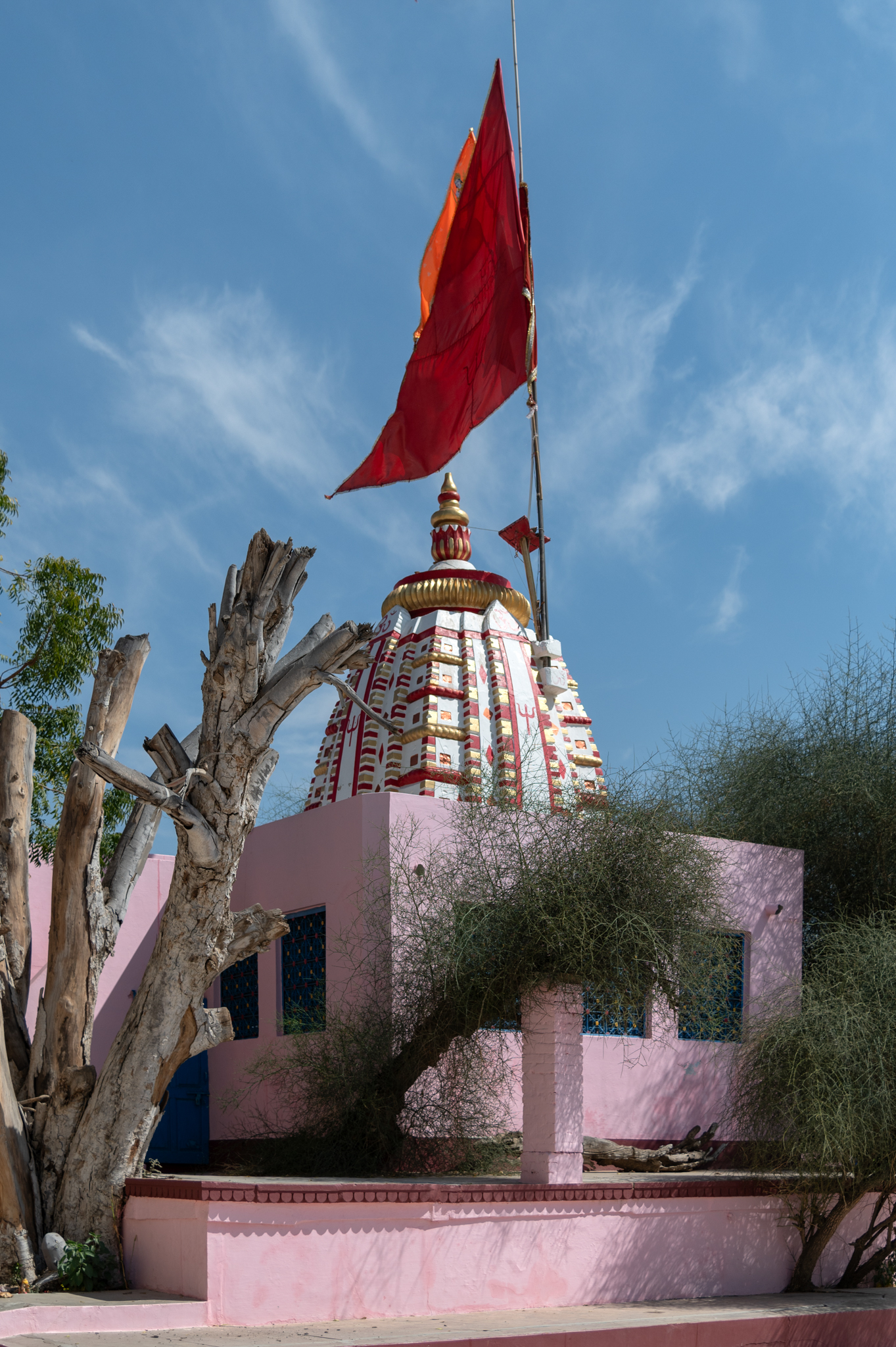
The west-facing view of the Suswani Mata Temple reveals a structure surrounded by a large courtyard. At the centre stands the old temple structure painted in white, red, and golden colours. There are a few sculptural fragments on the south side of the temple. A kera tree believed to be auspicious by the devotees of Suswani Mata is situated to the south of the temple.
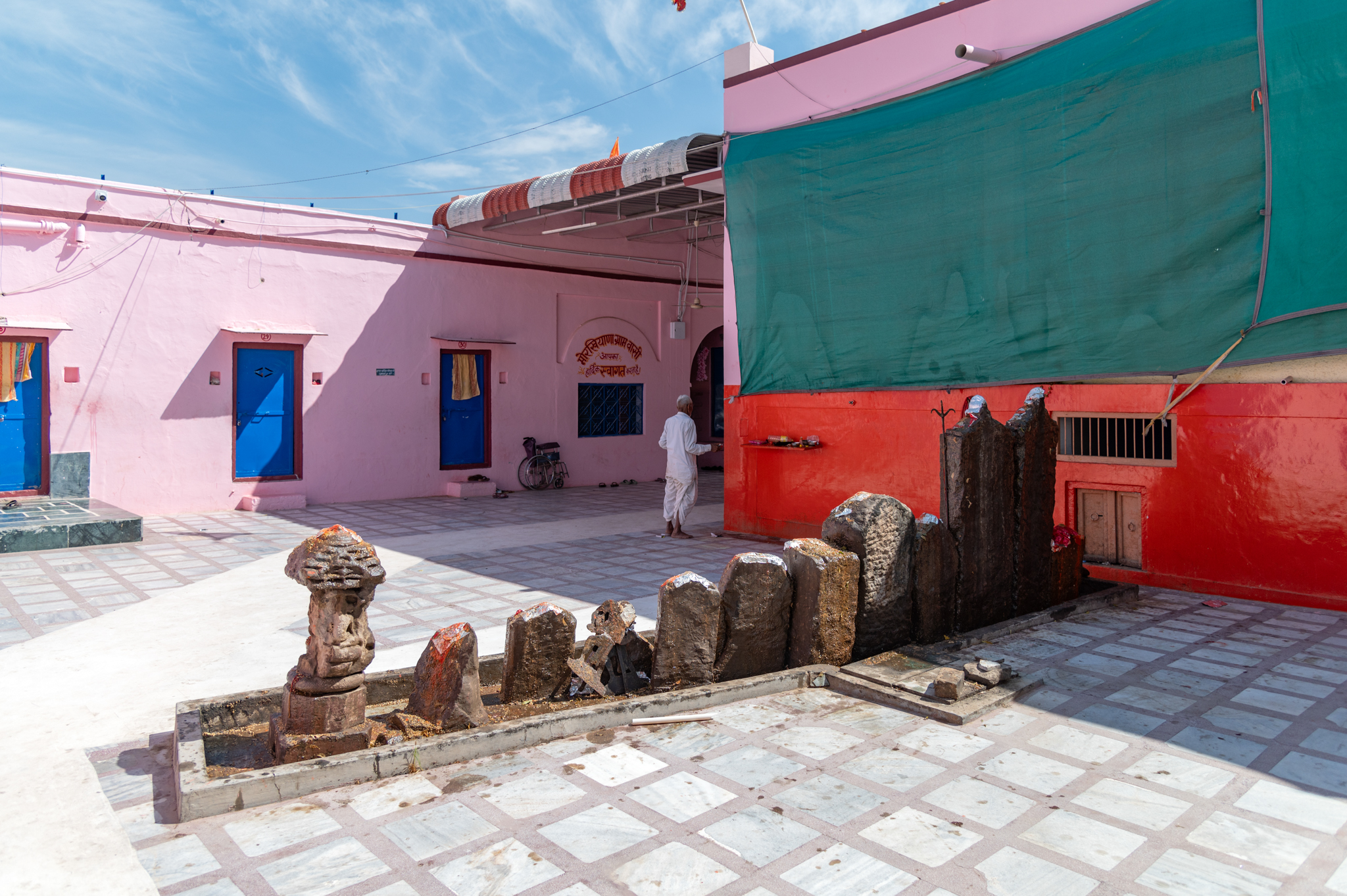
Seen here is the modern mandapa (pillared hall) of the Suswani Mata Temple. To its south side are some historical fragments consisting of Hero stones, which are worshipped as veeron ke pathar (stones of heroic people). The original location of these fragments is unknown, but today, they are an integral part of the rituals performed by devotees visiting the temple.
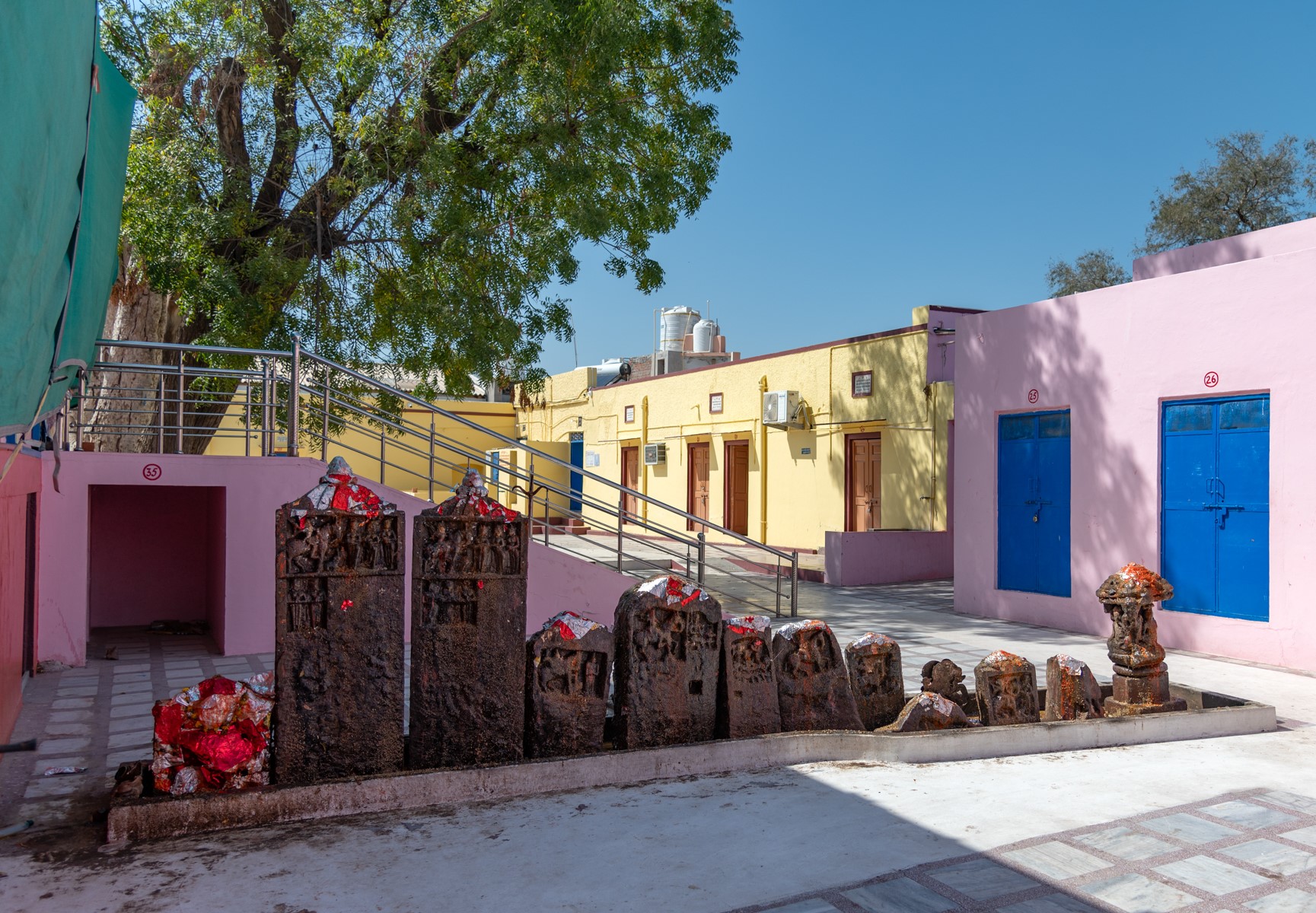
Twelve stone slab fragments of hero stones and sculptures are placed on a low pedestal. People worship the stones of brave souls and offer grains and sweets after smearing them with vermilion. The stone fragments are often rubbed with oil, which has seeped into the incisions of the inscriptions. Due to continuous worship, the intricate details of the slabs are lost.
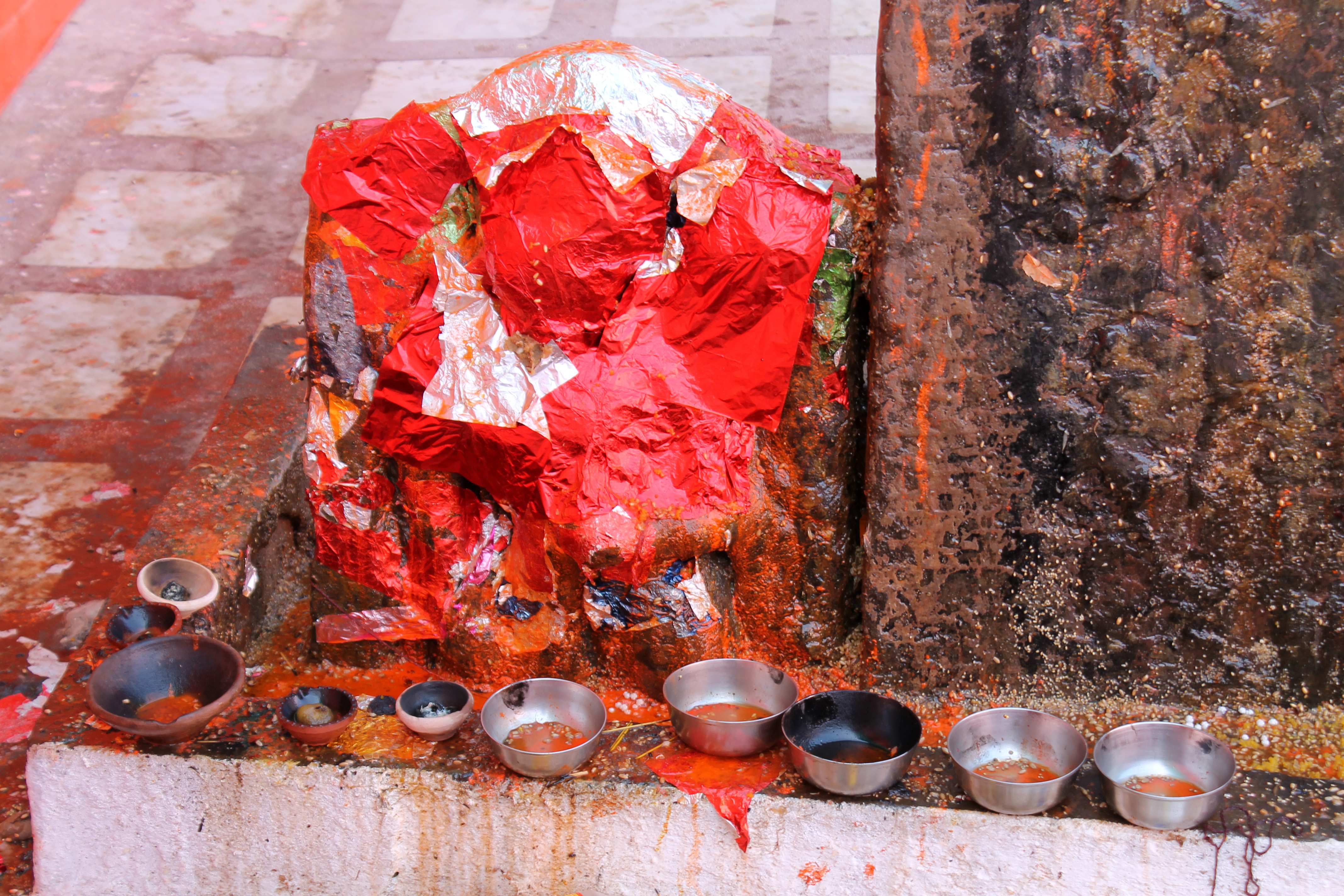
This is an unidentified fragment in the row of hero stones that are kept on the premises of Suswani Mata Temple. Today, the stone fragment is wrapped in a red paper sheet and revered by some as Ganesha. The original style and composition of the stone fragment are not known. The newly wrapped paper serves as an attempt to make them resemble Ganesha.
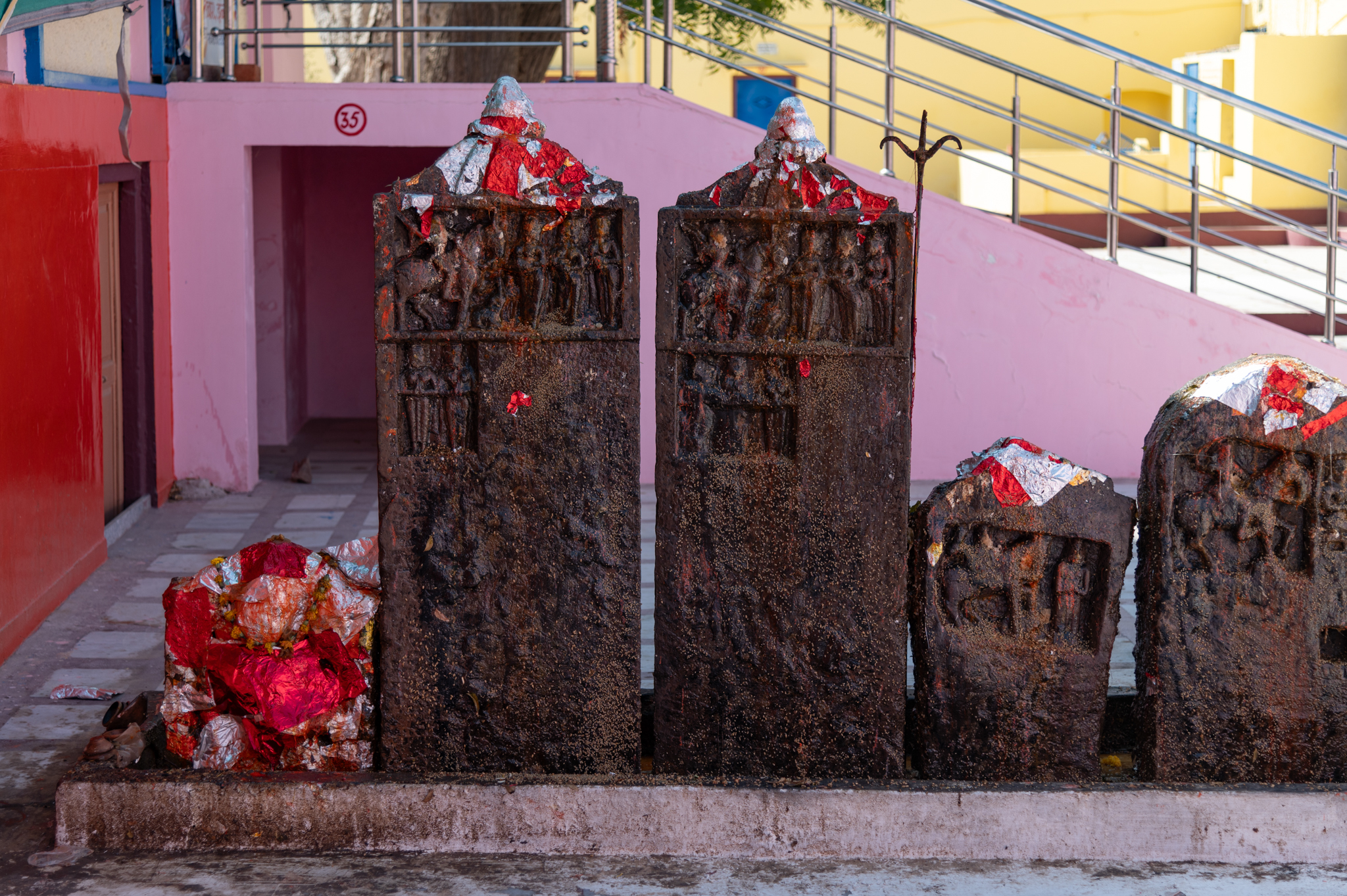
Seen here are two of the largest hero stones found among the fragments in the Suswani Mata Temple. Interestingly, both slabs feature a similar type of depiction where the upper half shows certain human figures while the lower half of the stone slab is empty. The finials of the hero stones are stylized as temple shikharas (superstructures), specifically latina shikharas (mono-spired). Approximately four feet in height and a half foot in width, these hero stones are unique specimens and constitute an important corpus of historical data. The plain portions of the stone slabs have very faint remains of inscriptions, which might contain information about the person in whose honour the hero stone was carved.
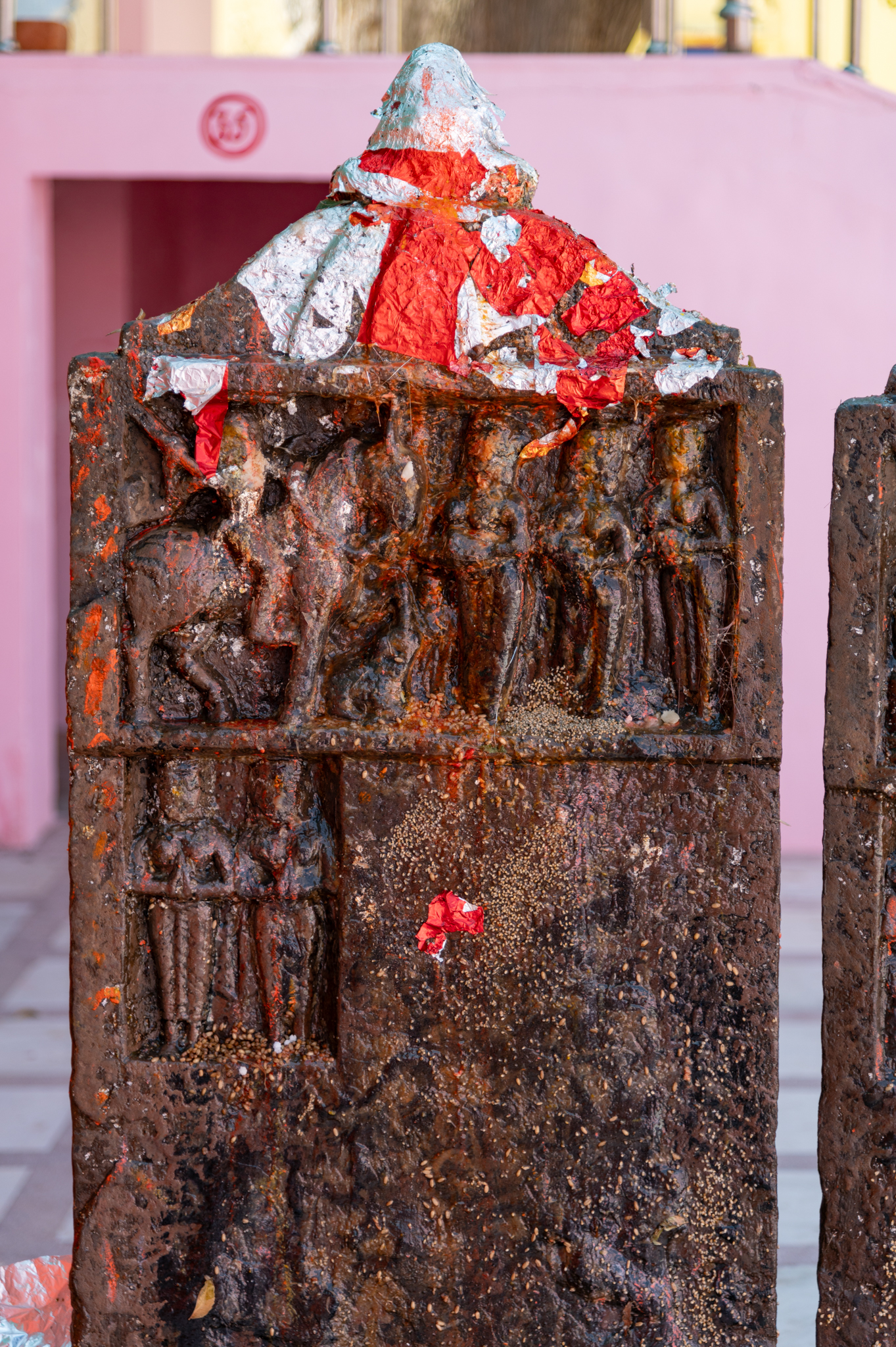
The topmost portion of the hero stone slab has a depiction of four figures, three standing on foot and one mounted on a horse. This is a depiction of the ‘hero’ who embarked on an expedition, fought against enemies, and ultimately lost his life on the battleground. The erection of the hero stones is a tribute to honour his heroic deeds and sacrifice. He is also accompanied by some other figures, but the vermilion and oil make them difficult to identify. The three figures standing in front of the hero may represent celestial damsels who are shown bowing down to him. However, due to the presence of vermilion and oil on the stone, discerning their identities is challenging.

In the second small panel in the hero stone, positioned just below the row depicting the hero, stand two female figures with folded hands in namaskar mudra (salutation gesture). Their upright posture is emphasized by their drapery, consisting of a decorated lower garment. The female figures represent celestial damsels believed to have arrived to escort the hero to heaven.
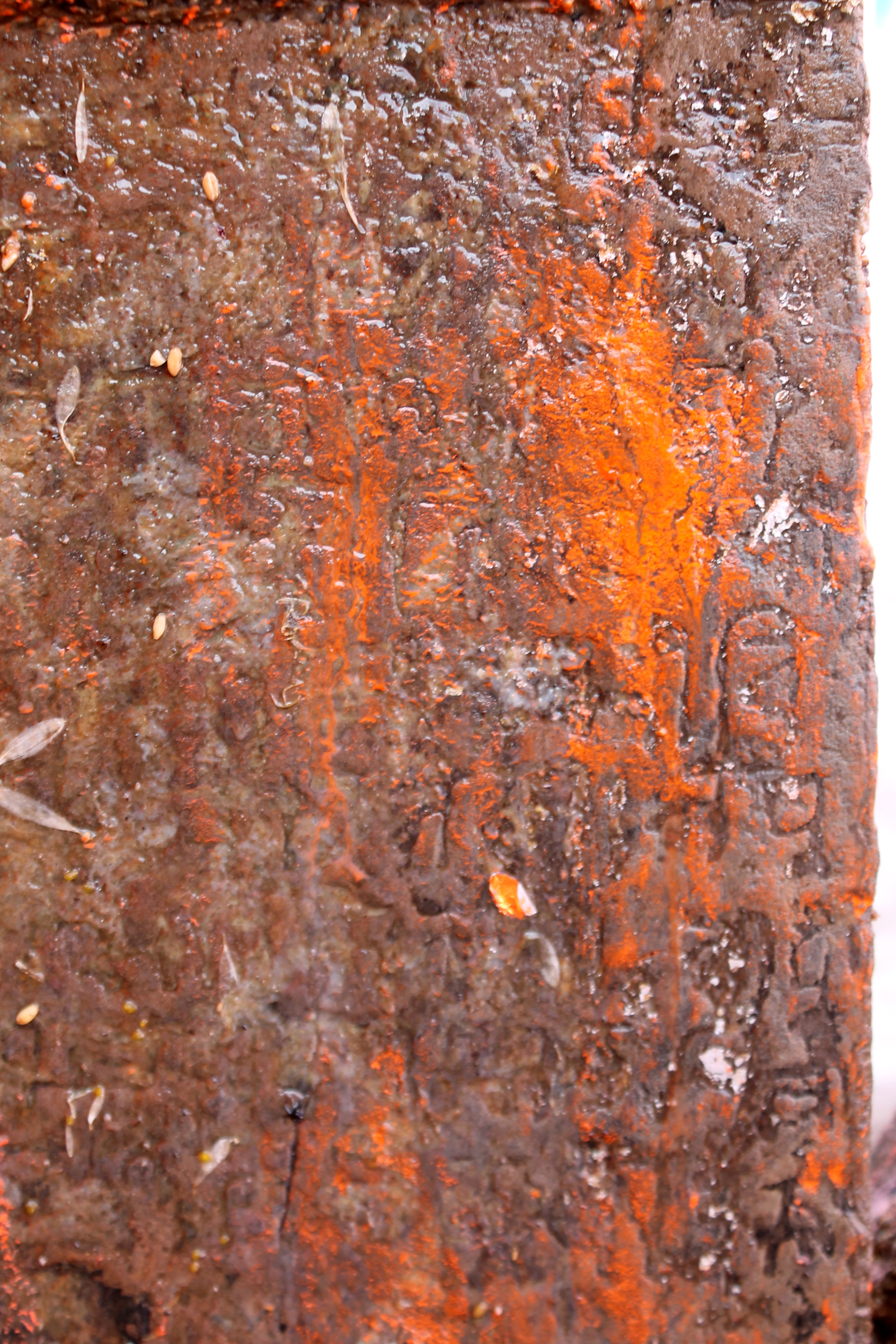
The hero stone slabs feature depictions of human figures in the upper half, while the lower half shows faint traces of inscriptions. Though illegible, closer examination suggests the inscriptions were likely written in the Devanagari script. The content of the inscription remains unknown, but typically, inscriptions on hero stones give details of the deceased and the time of the carving. Palaeographically, the script can tentatively be placed within a broad timeframe from the 12th to 15th centuries CE. However, due to the deteriorated condition of the stone slabs, no definitive conclusions can be drawn.
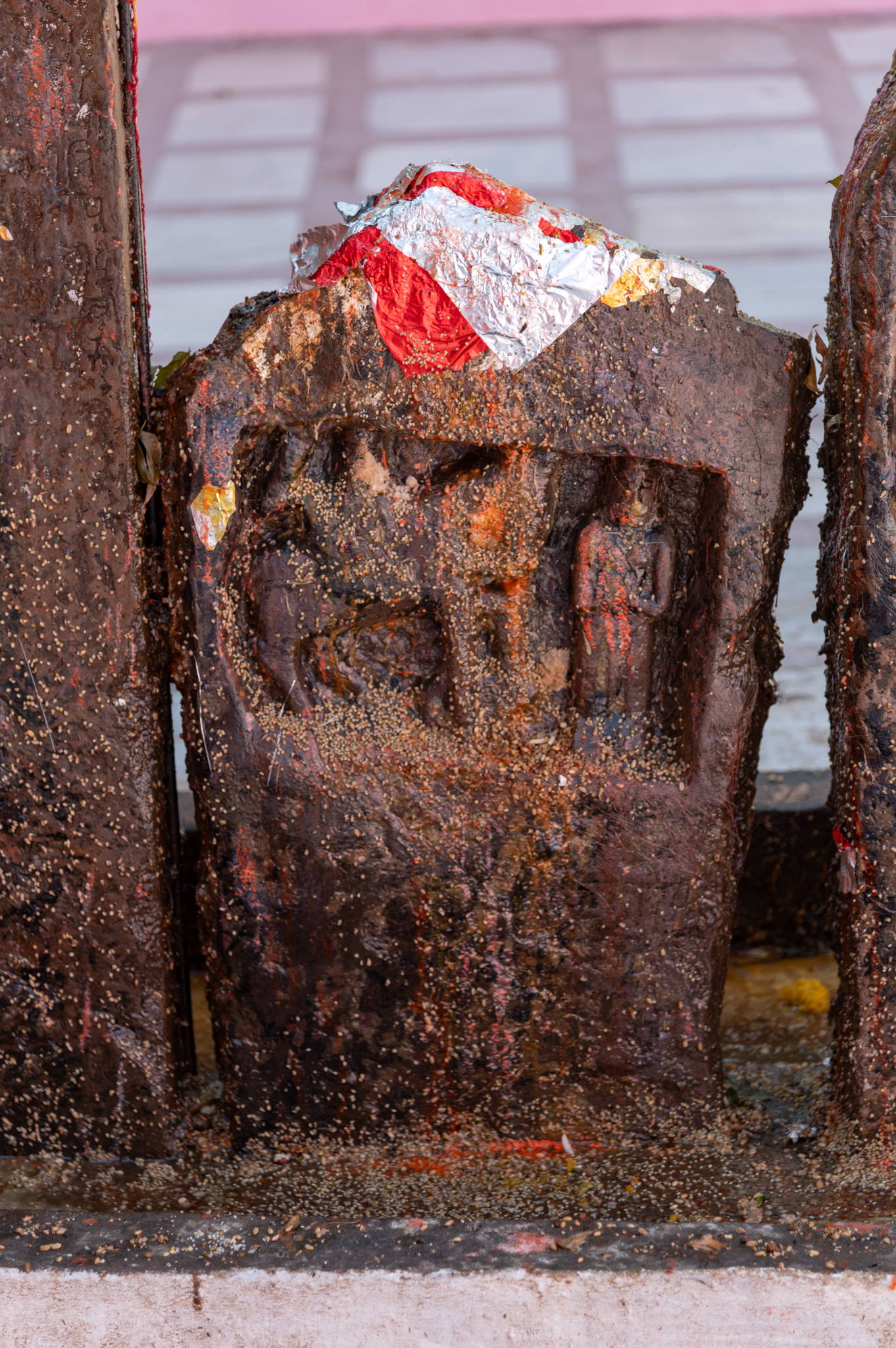
Another small stone fragment, likely a part of larger hero stones, is now housed in the premises of the Suswani Mata Temple. This fragment is noticeably less ornate compared to the larger stone slabs. It depicts only two figures one is the hero mounted on a horse, and the other is a figure standing with folded hands. The human figures are carved within rectangular niches on the fragment. There are no remaining traces of writing left on the lower side of this hero stone fragment.
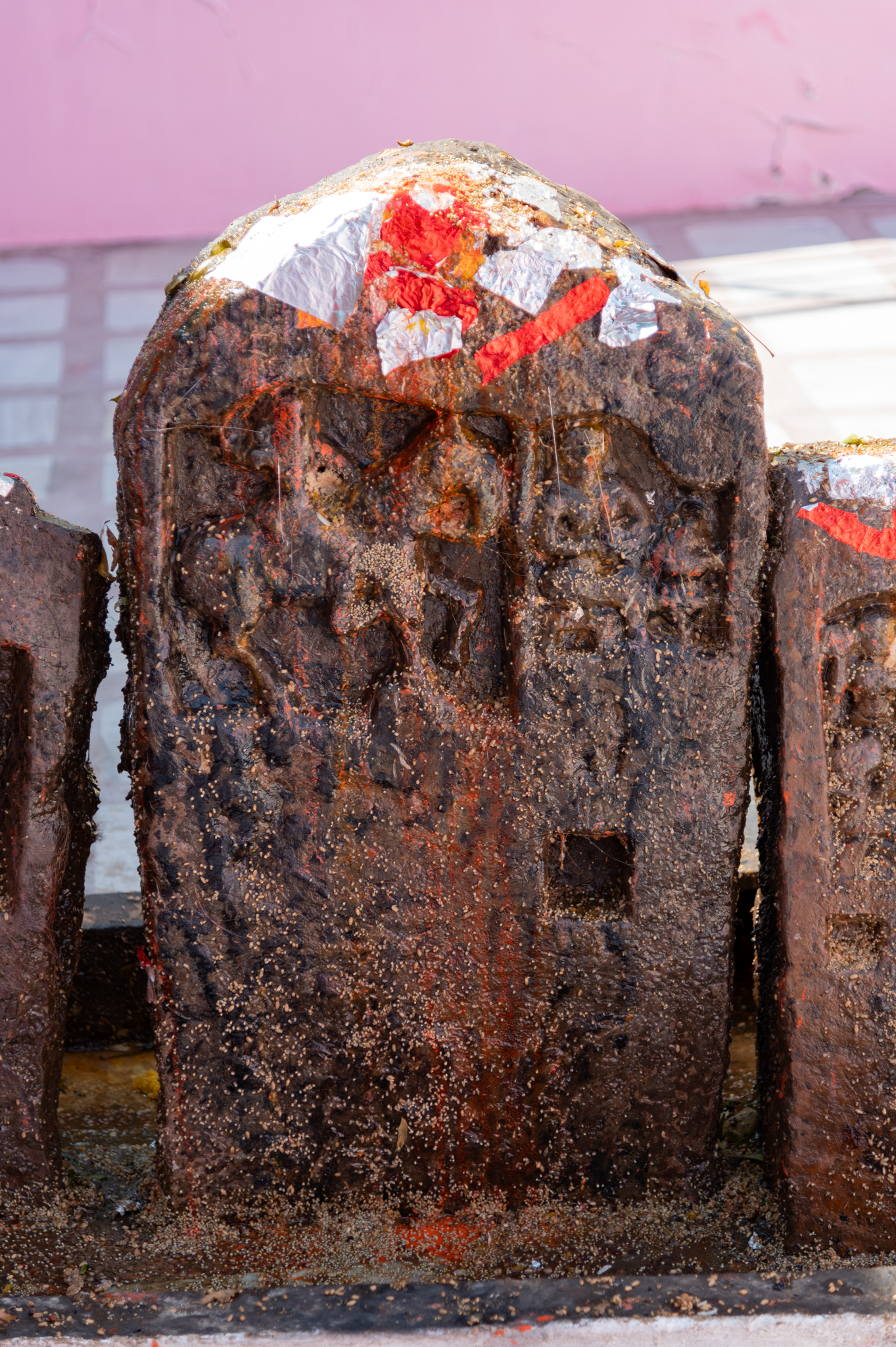
A hero stone fragment measures about a foot in height and half a foot in width, featuring a slightly different depiction than the other hero stones. In this fragment, the hero is portrayed mounted on a horse, accompanied not by a celestial damsel but by another human figure kneeling down. This second figure could also be a depiction of the hero. The scene symbolizes the hero’s journey to heaven after his death, where he bows down to God, often represented by the depiction of Shiva in his linga (aniconic representation of Shiva) form. The undulating stone surface of the hero stones makes it difficult to understand whether it originally contained any inscriptions.
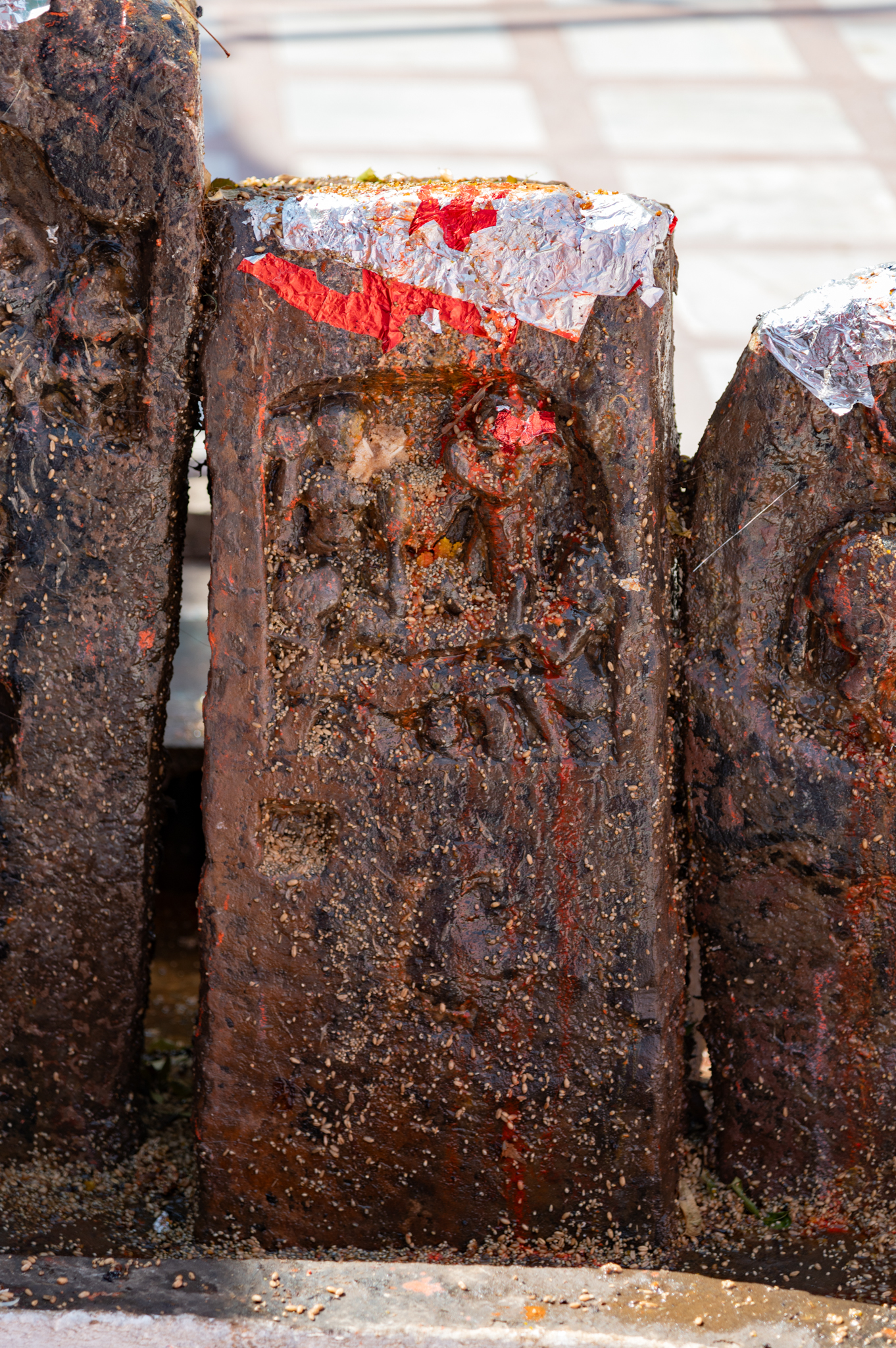
Seen here is a small-sized hero stone, similar in dimensions to the adjacent hero stones. It is a rectangular stone slab without a triangular finial. The panel depicting the hero and his journey to the heavenly abode differs slightly from others. Here, there is no figure mounted on horseback; instead, there is a supine human figure next to another figure standing with folded hands. The depiction likely indicates the hero’s death and his attainment of moksha (freedom from the eternal cycle of life, death, and rebirth). This unique portrayal is not found on any other hero stone fragments in the Suswani Mata Temple.

Seen here is a smaller hero stone, characterized by its simple ornamentation and minimal figural depiction. It features only a human figure mounted on horseback, representing the deceased hero. The plain stone surface of the hero stones may have originally included epigraphical etchings.
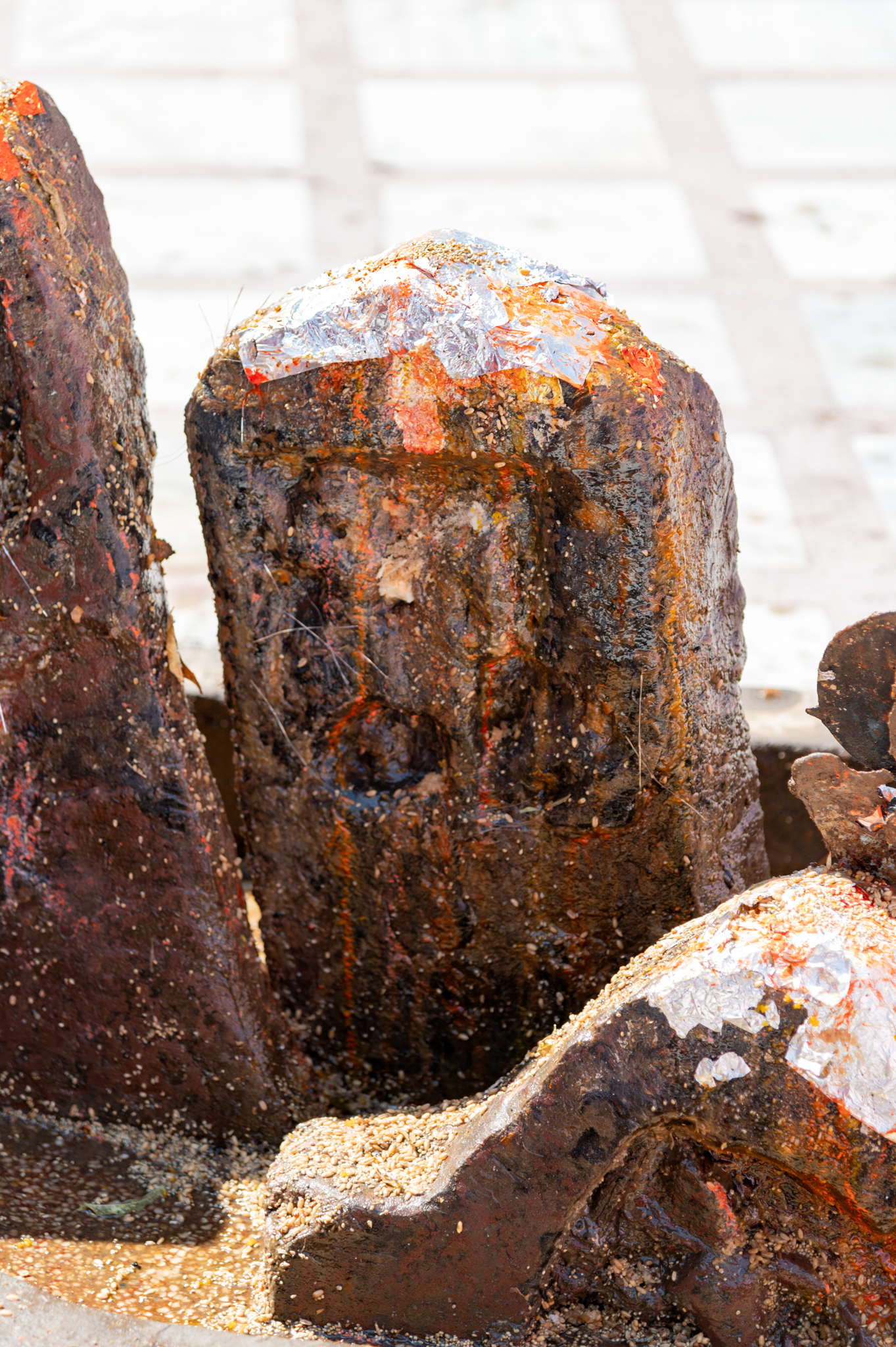
Seen here is one of the most damaged hero stone fragments found within the Suswani Mata Temple Complex. Carved on a rectangular slab with a triangular top, this fragment features figures carved inside a relief niche. Although not clearly visible, the carving depicts the hero riding on a horse. The presence of inscriptions on the lower portion of the hero stone is uncertain due to its condition. However, given its stylistic similarity to adjacent fragments, it is plausible that this fragment originally included some form of inscription.
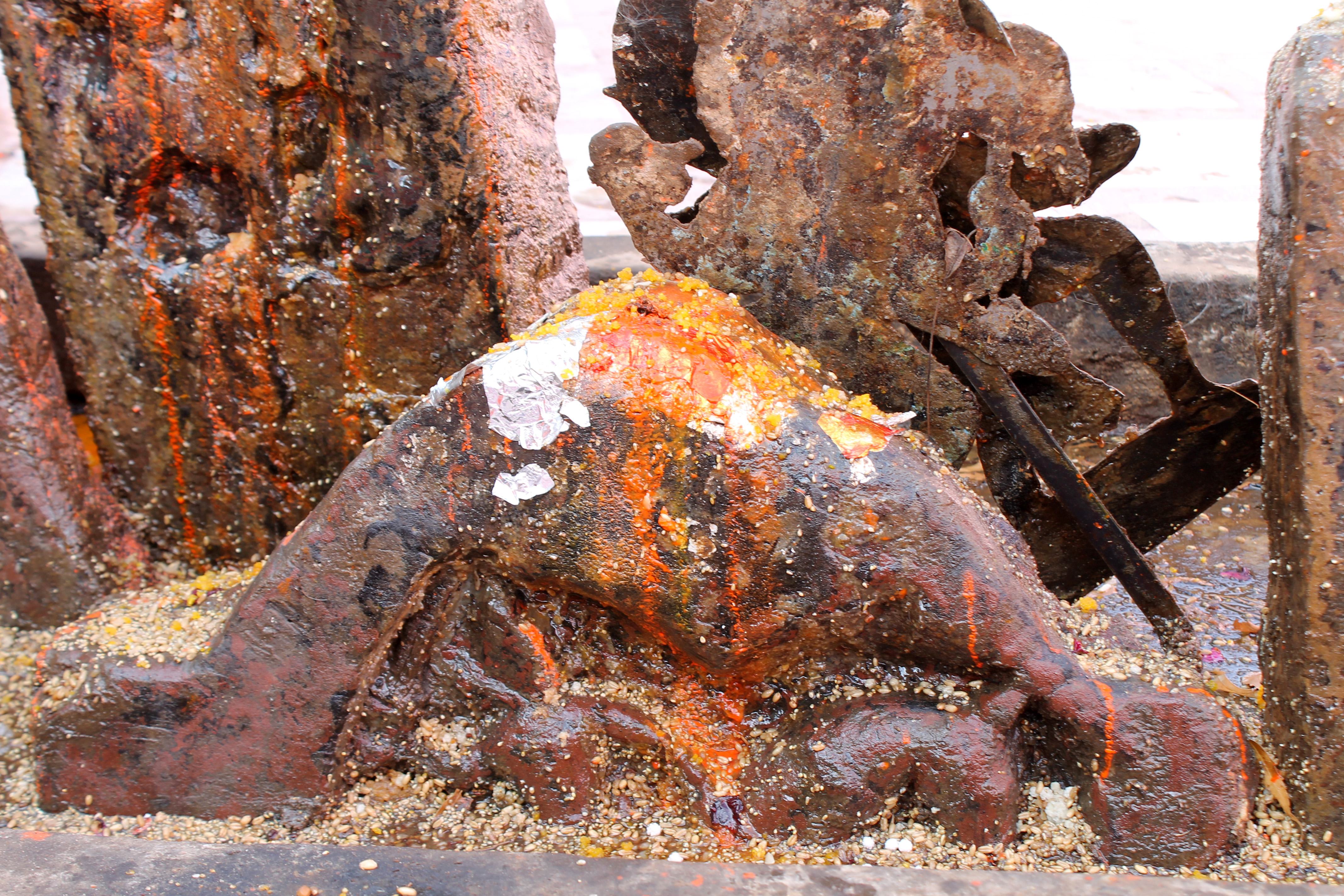
Seen here is a broken piece of a hero stone, once part of the temple’s architectural structure. Despite its fragmented state, it is now worshipped among the veeron ke pathar (stones of the heroic people). In its current aniconic form, this fragment receives the same reverence and rituals as the other fragments kept alongside.
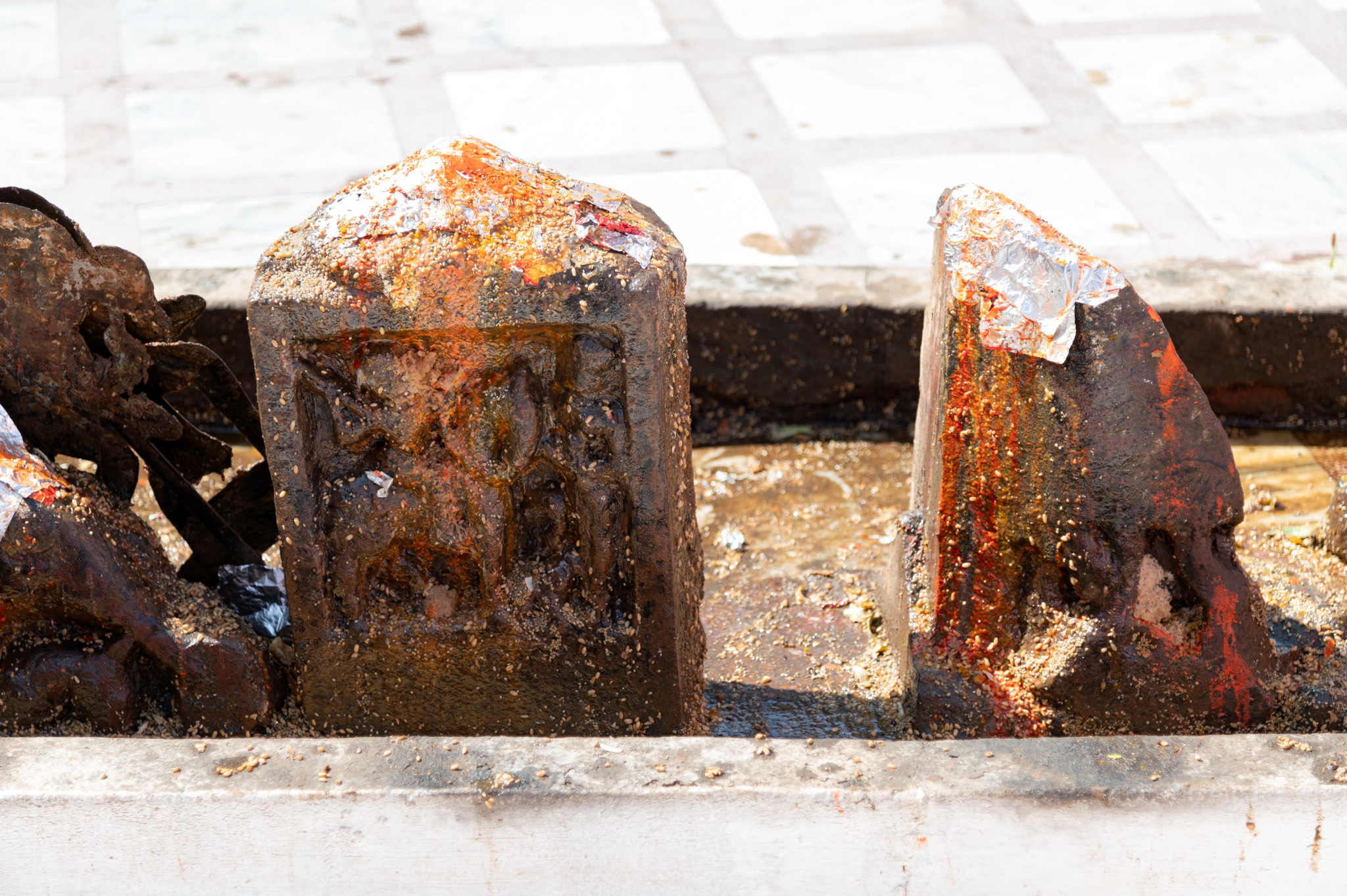
A fragmentary hero stone depicts the hero riding on horseback, wielding a sword and shield, poised for battle against the enemy. Adjacent to him stands a human figure with folded hands, likely another small figure kneels in front of the standing figure, bowing down. The narrative depicted on this hero stone is similar to other hero stones in the complex.
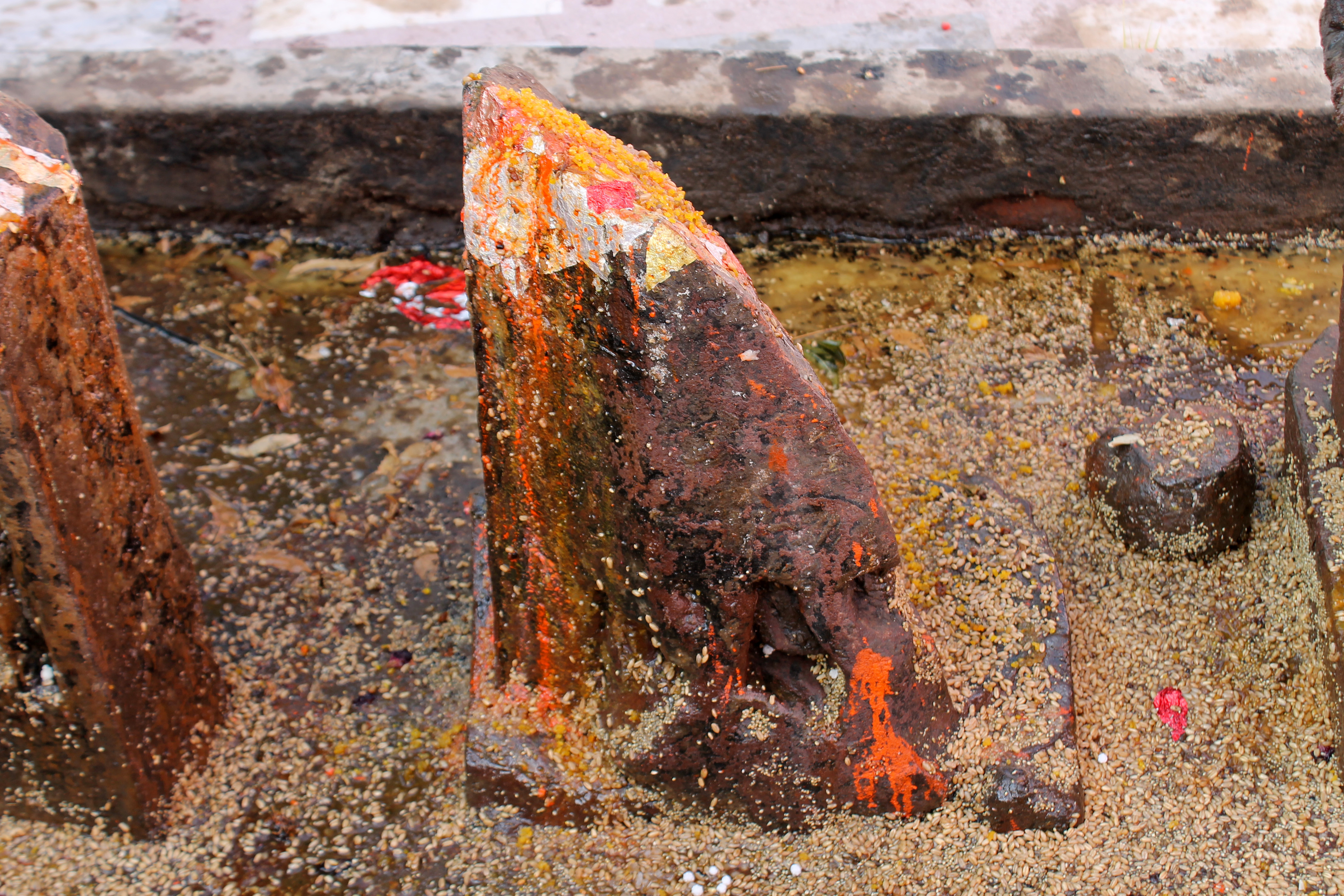
Seen here what appears to be a sculptural fragment among the row of hero stones. This speculation is drawn from faint traces of a human figure visible on the stone fragment. Given that the collection includes not only hero stones but also other pieces, it is plausible that a broken sculpture is venerated as a hero stone. Unlike other Hero stones, this fragment has a low pedestal.
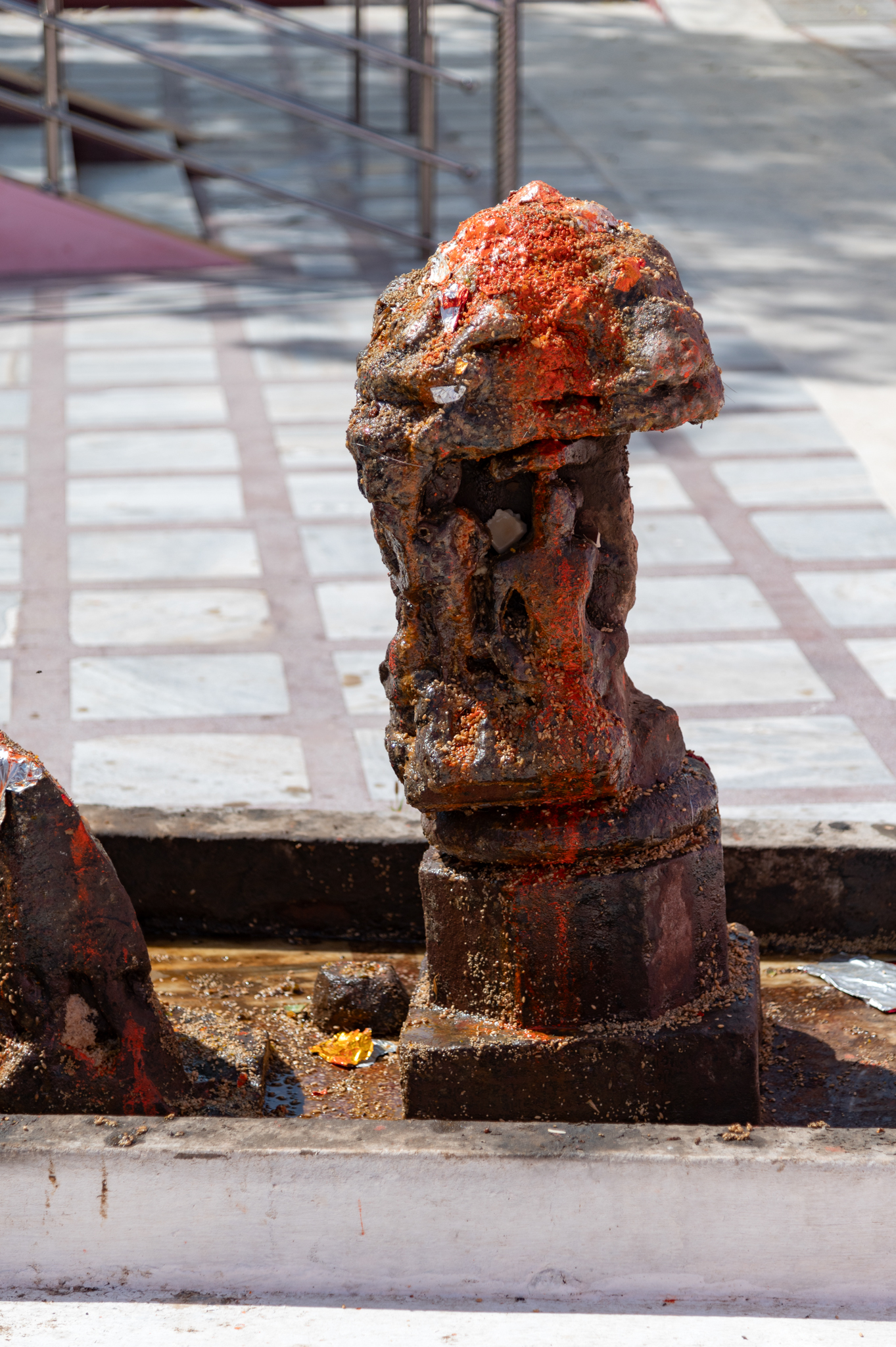
A pillar fragment with sculpture on its four sides, of which only two have survived. One image is of a seated Ganesha with four hands, and another is a seated male figure. The finial of the pillar fragment is shaped like a phamasana (pyramidical type) of shikhara (superstructure or spire). The spire has gavaksha (dormer window) motifs on the sides.

Seen here is another face of the sarvatobhadra (open from all sides), which features a depiction of a Ganesha icon. The four-handed image is depicted in a sitting posture, although the specific attributes of the icon are difficult to identify. The niche containing the Ganesha icon is topped by a pyramidal shikhara (superstructure). The Ganesha icon is characterized by long elongated ears, and the trunk curls up to rest on a bijapuraka (citron fruit).

There are a dozen architectural fragments, mainly consisting of hero stones (memorial stones), along with some pillar and sculptural fragments. The hero stones were installed here after being found scattered in the temple premises and the vicinity of the village. Today, these are propitiated as ‘veeron ke pathar’, depicting the journey of the hero (veer) through different panels, in whose memory the steles were installed.

A closer view of the shikhara (superstructure) of the sarvatobhadra (open from all sides) reveals it's stylized like a phamsana (pyramidal) shikhara. It consists of three mouldings that decrease in size, with a gavaksha (false window) on the frontal side of these mouldings. The mouldings are capped by a disc at the centre. The shikhara gives the sarvatobhadra the appearance of a miniature shrine.
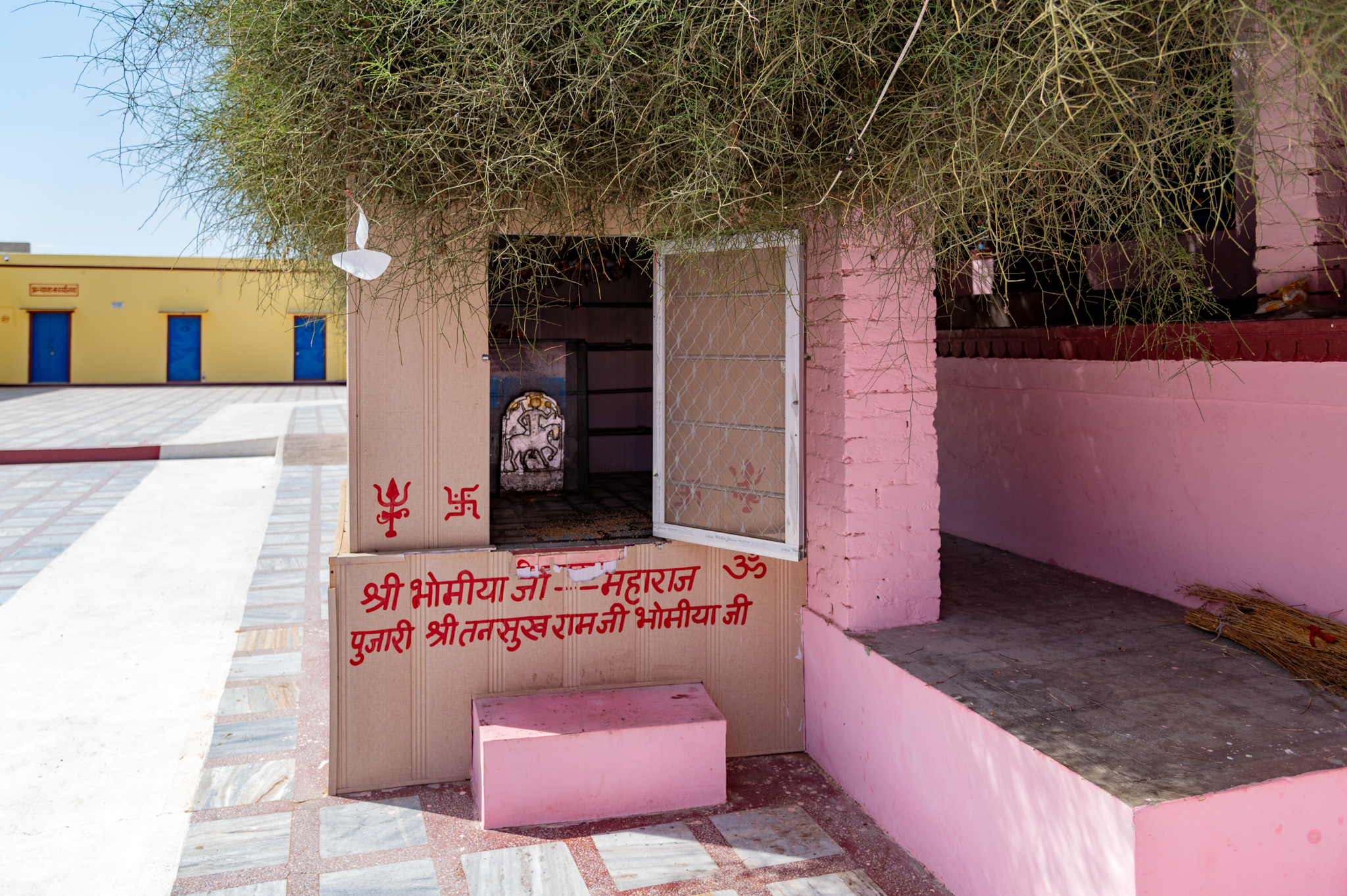
Seen here is a side shrine of the Bhomiya Maharaja on the premises of the Suswani Mata Temple next to the sacred Kera tree. The Kera tree is believed to be the spot where Suswani Ma manifested herself and eventually stayed at the location of the present-day temple.
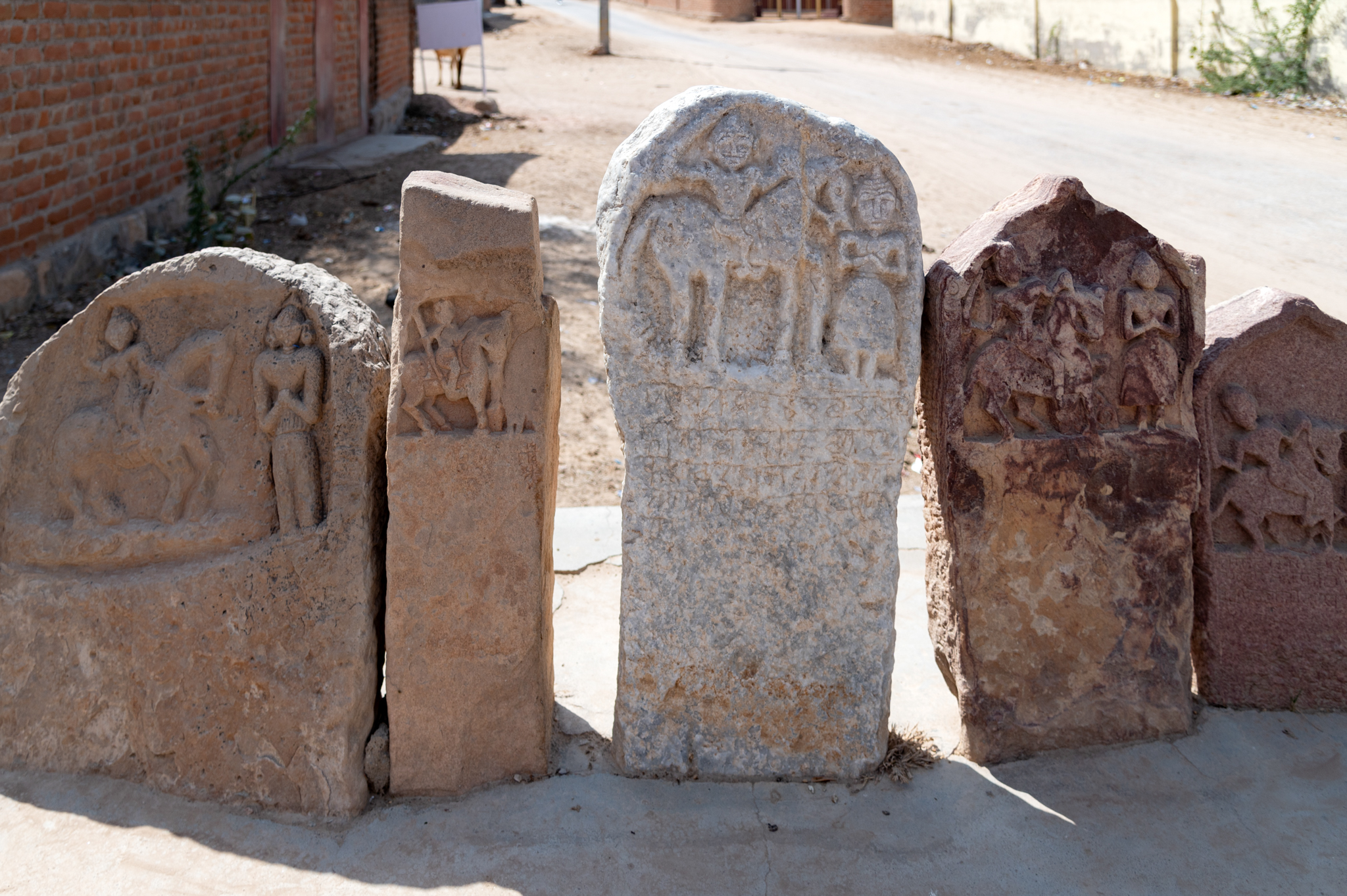
A row of hero stones (memorial stones) is installed near the Shiva Temple in the Morkhana village. This temple is a little away, to the north of the Suswani Mata Temple. The hero stones have depictions of male figures mounted on horses, sometimes along with a standing male figure in namaskar mudra (gesture of offering and devotion). Some of these are inscribed with dates from the 16th century CE.
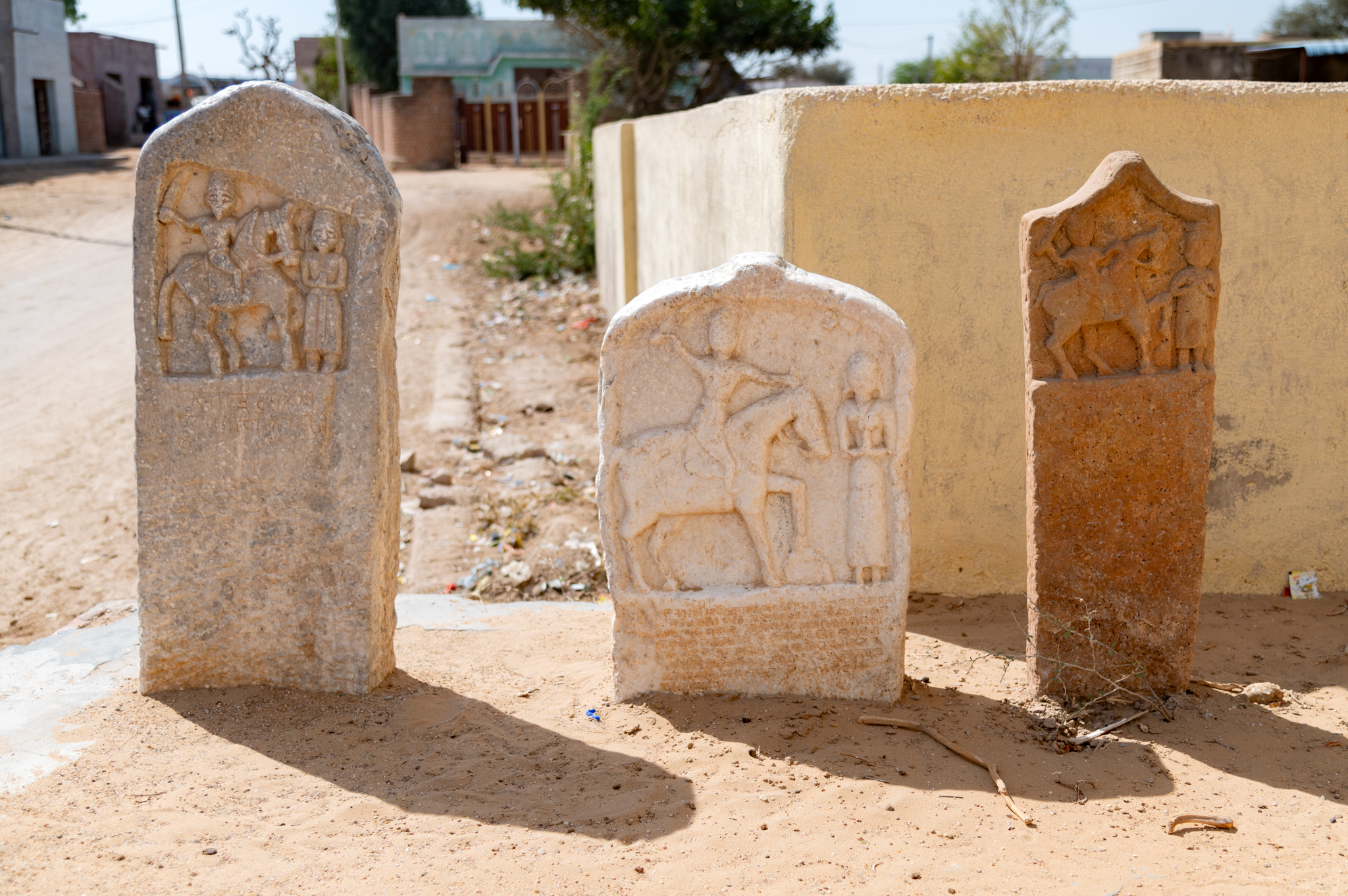
Typically, the front side of the Hero Stones depicts a hero riding on horseback, accompanied by a female figure standing in front of him with her hands folded in namaskar mudra (salutation gesture). The size of this depiction might vary on each stone, but they maintain stylistic similarity. Sometimes, these figures include inscriptions that provide details such as the person honoured by the hero stones and the date of its creation. The dates from legible inscriptions on the Hero stones are from 1500 VS onwards, placing them in the 15th-16th centuries CE.
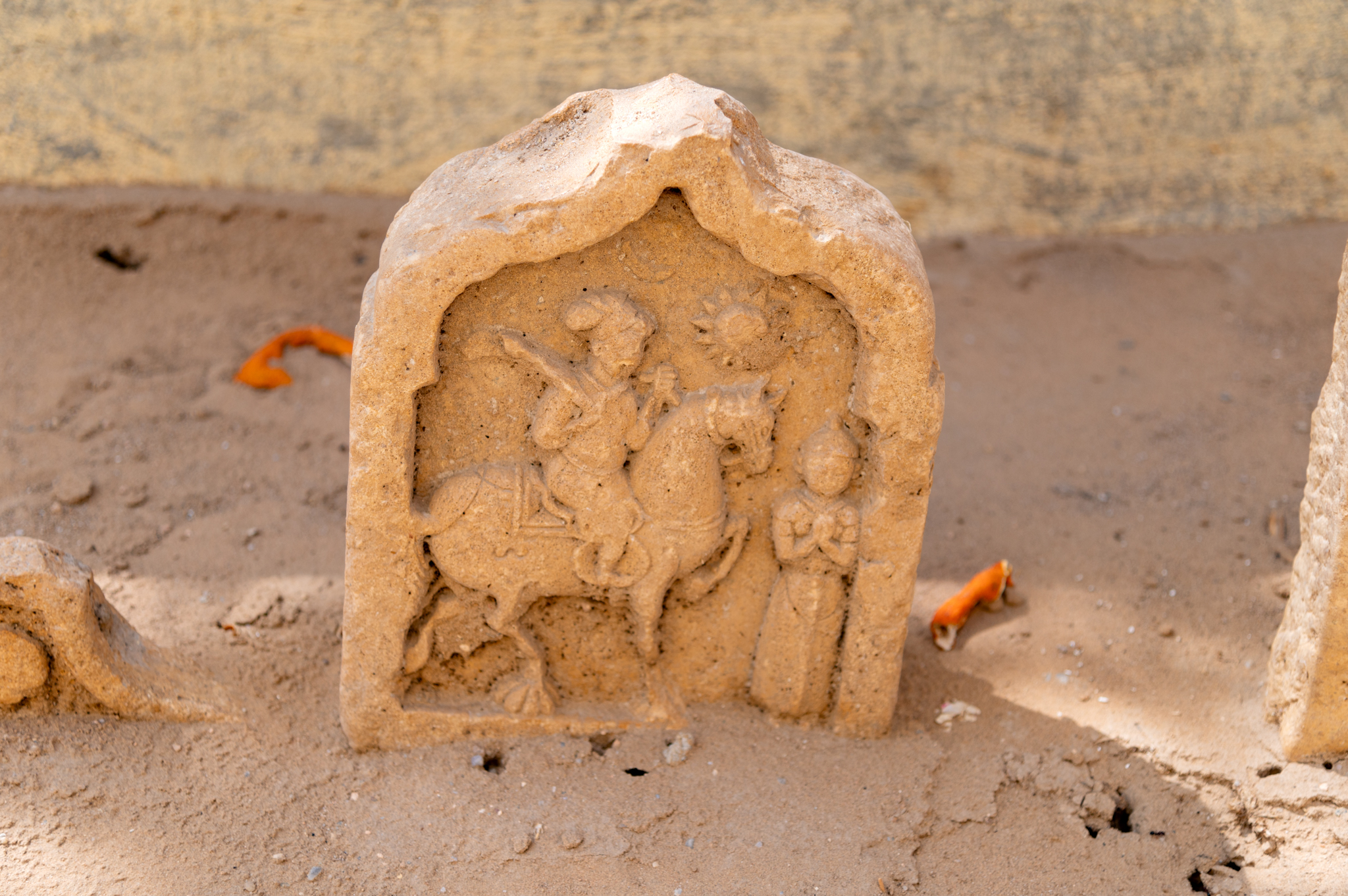
Seen here is an example of a hero stone without an inscription, showcasing a slightly different style. The niche inside which the hero is depicted is a low-relief niche with an arch design. The drapery of the hero and the celestial damsel accompanying him is uniquely rendered. The hero is depicted wearing a distinctive headgear resembling those worn in the Rajasthan region. In the corner of the niche, there is a sun motif, possibly symbolizing that the hero’s valour will endure eternally.
[1] Jain, Ancient Cities and Towns of Rajasthan, 424.
[2] Ojha, History of the Bikaner State (Hindi), 56–58.
Jain, K.C. Ancient Cities and Towns of Rajasthan: A Study of Culture and Civilization. Delhi: Motilal Banarsidass, 1972.
Ojha, Gaurishankar Hirachand. History of the Bikaner State (Hindi). Vol. 1. 2 vols. Ajmer: Vedic Yantralaya, 1939.
















